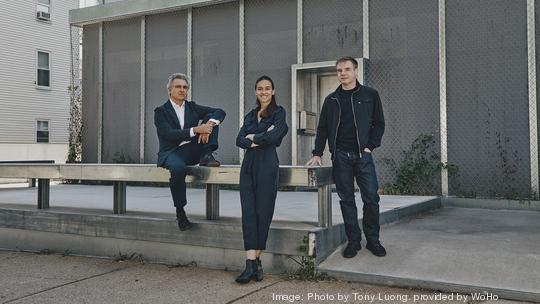
Anton Garcia-Abril and Debora Mesa, architects from MIT and Georgia Tech, respectively, have dedicated their lives to experimenting with light construction materials within their homes.
Two years ago, they quietly began working on a project designed to overhaul the construction industry with lightweight, prefabricated materials that can be used to build all kinds of structures. That project would eventually become WoHo, a startup spun out of MIT that officially made its debut this week.
WoHo, short for “World Home,” essentially reimagines prefabricated construction. The startup’s pitch is based around what it calls “Suites” and “Towers,” modular buildings made from sustainable materials that can be retooled into homes, retail spaces, laboratories or parking garages.
“Software will not change our built environment,” said Israel Ruiz, co-founder of WoHo and former executive vice president and treasurer of MIT. “It will make it better—regulate temperatures better, help us transact houses and apartments in an easier way—but we’re still going to need the physical space to socialize, to gather or to confine ourselves if that’s what we need to do.”
WoHo has a powerhouse founding team. The co-founders met at MIT back in 2012, when Garcia-Abril and Mesa joined the university and established the Prototypes of Prefabrication Laboratory (POPlab) in the MIT Center for Advanced Urbanism. They began working on initial designs for WoHo in 2018 but made slow progress on the project.
Ruiz stepped down from MIT in late 2019 to focus on opportunities that would “more directly accelerate innovation.” Just a few months later, the pandemic would provide a perfect opportunity for Ruiz, Garcia-Abril and Mesa to throw themselves fully into WoHo, especially as remote work and social distancing forced people to interact with their built environment in entirely new ways.
“Whatever you call home, your living room or office or lab space, is being thought of differently,” Ruiz said. “There are many people who are not being served well by the inefficiencies of the real estate and construction industries.”
WoHo aims to solve those inefficiencies that by reimagining construction supply chains, similar to how Amazon’s “last-mile” delivery service works. In the startup’s long-term vision, WoHo would have construction hubs all over the country, warehouses full of prefabricated components ready to be shipped nearby. That model would also make construction less pollutive, Ruiz pointed out; transportation as a whole accounts for more than a quarter of greenhouse gas emissions in the U.S.
As for the materials themselves, WoHo’s systems are made up of a series of discrete foundational components. Each component, produced in WoHo factories, will be 16 to 20 feet wide and can be connected or separated based on specific project needs. The materials are designed to be energy-efficient, and the production process is designed to generate minimal waste.
All told, WoHo expects to lower the costs of construction by more than 20 percent, cut project delivery time in half and reduce the ecological footprint of its buildings by 70 percent.
“We have very lofty goals,” Ruiz said. “We’re changing the approach to how we produce materials and where we produce those materials.”
WoHo has kick-started its mission with $4.5 million in seed funding led by The Engine, MIT’s venture fund dedicated to “tough tech” problems. The startup is currently housed within The Engine in Cambridge. In concert with the funding announcement on Thursday, WoHo also announced a partnership with building materials conglomerate LafargeHolcim in the United States.
WoHo is conducting its first pilot at the WoHo Lab in Madrid and plans to build one in Boston to begin producing components here within the next three to six months. For Ruiz, Boston is well-suited to be WoHo’s hub going forward, with a wealth of engineering talent, opportunities for capital and connections formed from his years at MIT.
“We believe that in order to bring forward a company like this and to succeed at what it actually is—not a sprint, but a marathon run at a very fast clip—this region is much better suited to advance that mission,” Ruiz said.



